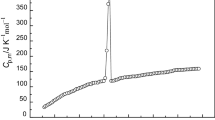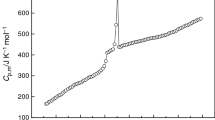Abstract
The heat capacities of 1-butyl-3-methylimidazolium lactate ionic liquids ([C4mim][Lact]) were measured with a highly accurate automatic adiabatic calorimeter over the temperature range from 79 to 406 K. And the experimental values of molar heat capacities were fitted to a polynomial equation using least square method in the appropriate temperature ranges. The standard molar heat capacity was determined to be 1734.46 ± 5.12 J K−1 mol−1 at 298.15 K. The molar enthalpy and molar entropy of the transition were determined to be 15.575 ± 0.045 and 64.44 ± 0.14 J K−1 mol−1. Other thermodynamic properties, such as (HT − H298.15) and (ST − S298.15), were also calculated. Furthermore, when the temperature reaches 241.87 K, the strongest peaks appeared by analysis of the heat capacity curve. This phenomenon could be explained from the interionic interaction, which is the hydrogen bond between the anions and cations.


Similar content being viewed by others
References
Wasserscheid P, Boemanna A, Bolm C. Synthesis and performance of ionic liquids determined from the “chiral pool”. Chem Commun. 2002;3:200–1.
Baudequin C, Bregeon D, Levillain J. Chiral ionic liquids, a renewal for the chemistry of chiral solvents? Design, synthesis and applications for chiral recognition and asymmetric synthesis. Tetrahedron Asymmetry. 2005;16:3921–45.
Clavier H, Boulanger L, Audi N, Toupet L, Mauduit M, Guillemin JC. Design and synthesis of imidazolinium salts derived from (L)-valine. investigation of their potential in chiral molecular recognition. Chem Commun. 2004;10:1224–5.
Ding J, Welton T, Armstrong DW. Chiral ionic liquids as stationary phases in gas chromatography. Anal Chem. 2004;76:6819–22.
Bao W, Wang Z, Li Y. Synthesis of chiral ionic liquids from natural amino acids. J Org Chem. 2003;68:591–3.
Fukumoto K, Yoshizawa M, Ohno H. Room temperature ionic liquids from 20 natural amino acids. J Am Chem Soc. 2005;127:2398–9.
Tao GH, He L, Sun N, Kou Y. New generation ionic liquids: cations derived from amino acids. Chem Commun. 2005;28:3562–4.
Allen CR, Richard PL, Ward AJ, van de Water LGA, Masters AF, Maschmeyer T. Facile synthesis of ionic liquids possessing chiral carboxylates. Tetrahedron Lett. 2006;47:7367–70.
Jiang YY, Wang GN, Zhou Z, Wu YT, Geng J, Zhang ZB. Tetraalkylammonium amino acids as functionalized ionic liquids of low viscosity. Chem Commun. 2008;4:505–7.
Earle MJ, McCormac PB, Seddon KR. Diels-Alder reactions in ionic liquids. A safe recyclable alternative to lithium perchlorate–diethyl ether mixtures. Green Chem. 1999;1:23–5.
Fang DW, Tong J, Guan W, Wang H, Yang JZ. Prediction of the thermodynamic properties of 1-alkyl-3-methylimidazolium lactate ionic liquids [Cnmim][Lact] (n = 2, 3, 4, 5, and 6) by parachor. Sci China Chem. 2010;53:2564–70.
Jiang HC, Zhao Y, Wang JY, Zhao FY, Liu RJ, Hu YQ. Density and surface tension of pure ionic liquid 1-butyl-3-methyl-imidazolium l-lactate and its binary mixture with alcohol and water. J Chem Thermodyn. 2013;64:1–13.
Zheng L, Bu XX, Fan BH, Wei J, Xing NN, Guan W. Study on thermodynamic property for ionic liquid [C4mim][Lact](1-butyl-3-methylimidazolium lactic acid). J Therm Anal Calorim. 2016;123:1619–25.
Dupont J, Suarez PAZ, Souza RF, Burrow RA, Kintzinger JP. C_H-π Interactions in 1-n-butyl-3-methylimidazolium tetraphenylborate molten salt: solid and solution structures. Chem Eur J. 2000;6:2377–81.
Hagiwara R, Ito YJ. Room temperature ionic liquids of alkylimidazolium cations and fluoroanions. Fluor Chem. 2000;105:221–7.
der Schrö U, Wadhawan JD, Compton RG, Marken F, Suarez PAZ, Consorti CS, de Souza RF, Dupont J. Water-induced accelerated ion diffusion: voltammetric studies in 1-methyl-3-[2,6-(S)-dimethylocten-2-yl]imidazolium tetrafluoroborate, 1-butyl-3-methylimidazolium tetrafluoroborate and hexafluorophosphate ionic liquids. New J Chem. 2000;24:1009–15.
Tan ZC, Sun LX, Meng SH, Li L, Zhang JB. Heat capacities and thermodynamic functions of p-chlorobenzoic acid. Chem J Chin Univ. 2002;34:1417 (in China).
Tan ZC, Sun GY, Song YJ, Wang L, Han JR, Wang M. An adiabatic calorimeter for heat capacity measurement of small samples-the heat capacity of nonlinear optical materials KTiOPO4 and RbTiOAsO4 crystals. Thermochim Acta. 2000;247:252–3.
Tan ZC, Di YY. Review of modern low-temperature adiabatic calorimetry. Prog Chem. 2006;18:1234 (in China).
Ditmars DA, Ishihara S, Chang SS, Bernstein G, Wes ED. Enthalpy and heat-capacity standard reference material: synthetic sapphire (α-Al2O3) from 10 to 2250 K. J Res Natl Bur Stand. 1982;87:159–63.
He HY, Zheng YZ, Chen H, Zhang XC, Yao XQ, Zhang SJ. Computational studies of the structure and cation-anion interactions in 1-ethyl-3-methylimidazolium lactate ionic liquid. Sci China Chem. 2012;55:1548–56.
Acknowledgements
This project was financially supported by National Nature Science Foundation of China NSFC (Nos. 21673107, 21471073, 21373005) and National Key Technology R&D Program 2015BAB03B03.
Author information
Authors and Affiliations
Corresponding author
Electronic supplementary material
Below is the link to the electronic supplementary material.
Rights and permissions
About this article
Cite this article
Fang, DW., Zuo, Jt., Xia, MC. et al. Low-temperature heat capacity and standard thermodynamic functions of 1-butyl-3-methylimidazolium lactate. J Therm Anal Calorim 133, 1015–1021 (2018). https://doi.org/10.1007/s10973-018-7131-0
Received:
Accepted:
Published:
Issue Date:
DOI: https://doi.org/10.1007/s10973-018-7131-0




